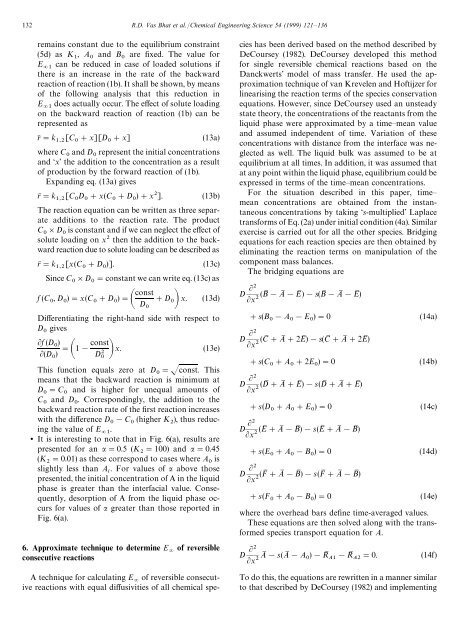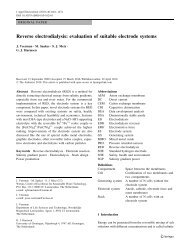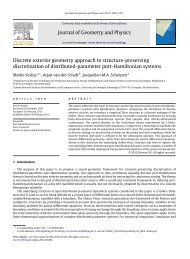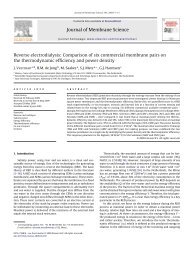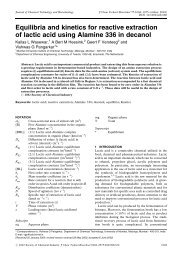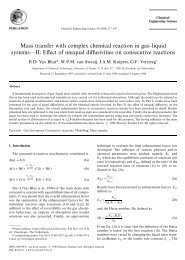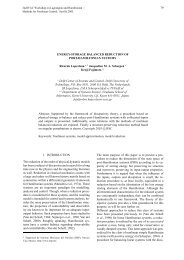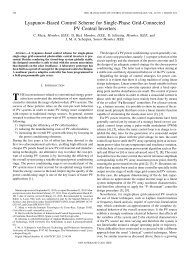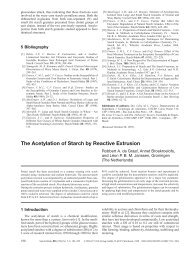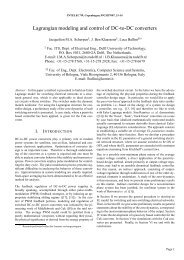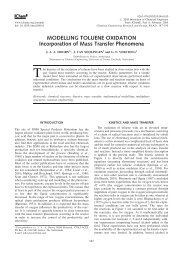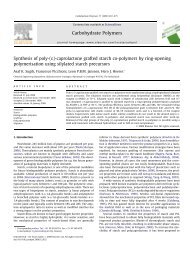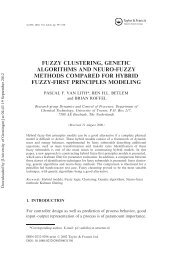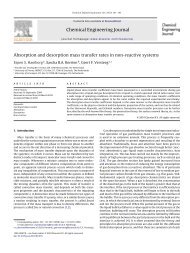Mass transfer with complex chemical reaction in gas—liquid ... - ITM
Mass transfer with complex chemical reaction in gas—liquid ... - ITM
Mass transfer with complex chemical reaction in gas—liquid ... - ITM
You also want an ePaper? Increase the reach of your titles
YUMPU automatically turns print PDFs into web optimized ePapers that Google loves.
132 R.D. Vas Bhat et al./Chemical Eng<strong>in</strong>eer<strong>in</strong>g Science 54 (1999) 121—136rema<strong>in</strong>s constant due to the equilibrium constra<strong>in</strong>t(5d) as K , A and B are fixed. The value for E can be reduced <strong>in</strong> case of loaded solutions ifthere is an <strong>in</strong>crease <strong>in</strong> the rate of the backward<strong>reaction</strong> of <strong>reaction</strong> (1b). It shall be shown, by meansof the follow<strong>in</strong>g analysis that this reduction <strong>in</strong>E does actually occur. The effect of solute load<strong>in</strong>gon the backward <strong>reaction</strong> of <strong>reaction</strong> (1b) can berepresented asr "k [C #x][D #x](13a) where C and D represent the <strong>in</strong>itial concentrations and ‘x’ the addition to the concentration as a resultof production by the forward <strong>reaction</strong> of (1b).Expand<strong>in</strong>g eq. (13a) givesrN "k [C D #x(C #D )#x]. (13b) The <strong>reaction</strong> equation can be written as three separateadditions to the <strong>reaction</strong> rate. The productC D is constant and if we can neglect the effect of solute load<strong>in</strong>g on x then the addition to the backward<strong>reaction</strong> due to solute load<strong>in</strong>g can be described asrN "k [x(C #D )].(13c) S<strong>in</strong>ce C D "constant we can write eq. (13c) as f (C , D )"x(C #D )" const #DD x. (13d)Differentiat<strong>in</strong>g the right-hand side <strong>with</strong> respect toD gives f (D )(D ) " 1!const D x.(13e)This function equals zero at D "const. Thismeans that the backward <strong>reaction</strong> is m<strong>in</strong>imum atD "C and is higher for unequal amounts ofC and D . Correspond<strong>in</strong>gly, the addition to thebackward <strong>reaction</strong> rate of the first <strong>reaction</strong> <strong>in</strong>creases<strong>with</strong> the difference D !C (higher K ), thus reduc<strong>in</strong>gthe value of E .z It is <strong>in</strong>terest<strong>in</strong>g to note that <strong>in</strong> Fig. 6(a), results arepresented for an α"0.5 (K "100) and α"0.45(K "0.01) as these correspond to cases where A isslightly less than A . For values of α above thosepresented, the <strong>in</strong>itial concentration of A <strong>in</strong> the liquidphase is greater than the <strong>in</strong>terfacial value. Consequently,desorption of A from the liquid phase occursfor values of α greater than those reported <strong>in</strong>Fig. 6(a).6. Approximate technique to determ<strong>in</strong>e E of reversibleconsecutive <strong>reaction</strong>sA technique for calculat<strong>in</strong>g E of reversible consecutive<strong>reaction</strong>s <strong>with</strong> equal diffusivities of all <strong>chemical</strong> specieshas been derived based on the method described byDeCoursey (1982). DeCoursey developed this methodfor s<strong>in</strong>gle reversible <strong>chemical</strong> <strong>reaction</strong>s based on theDanckwerts’ model of mass <strong>transfer</strong>. He used the approximationtechnique of van Krevelen and Hoftijzer forl<strong>in</strong>earis<strong>in</strong>g the <strong>reaction</strong> terms of the species conservationequations. However, s<strong>in</strong>ce DeCoursey used an unsteadystate theory, the concentrations of the reactants from theliquid phase were approximated by a time—mean valueand assumed <strong>in</strong>dependent of time. Variation of theseconcentrations <strong>with</strong> distance from the <strong>in</strong>terface was neglectedas well. The liquid bulk was assumed to be atequilibrium at all times. In addition, it was assumed thatat any po<strong>in</strong>t <strong>with</strong><strong>in</strong> the liquid phase, equilibrium could beexpressed <strong>in</strong> terms of the time—mean concentrations.For the situation described <strong>in</strong> this paper, time—mean concentrations are obta<strong>in</strong>ed from the <strong>in</strong>stantaneousconcentrations by tak<strong>in</strong>g ‘s-multiplied’ Laplacetransforms of Eq. (2a) under <strong>in</strong>itial condition (4a). Similarexercise is carried out for all the other species. Bridg<strong>in</strong>gequations for each <strong>reaction</strong> species are then obta<strong>in</strong>ed byelim<strong>in</strong>at<strong>in</strong>g the <strong>reaction</strong> terms on manipulation of thecomponent mass balances.The bridg<strong>in</strong>g equations areD (BM !AM !EM )!s(BM !AM !EM )x#s(B !A !E )"0D (CM #AM #2EM )!s(CM #AM #2EM )x#s(C #A #2E )"0D (DM #AM #EM )!s(DM #AM #EM )x#s(D #A #E )"0D (EM #AM !BM )!s(EM #AM !BM )x#s(E #A !B )"0D (FM #AM !BM )!s(FM #AM !BM )x#s(F #A !B )"0(14a)(14b)(14c)(14d)(14e)where the overhead bars def<strong>in</strong>e time-averaged values.These equations are then solved along <strong>with</strong> the transformedspecies transport equation for A.D x AM !s(AM !A )!RM !RM "0.(14f)To do this, the equations are rewritten <strong>in</strong> a manner similarto that described by DeCoursey (1982) and implement<strong>in</strong>g


